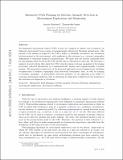Informative path planning for anomaly detection in environment exploration and monitoring
Author(s)
Blanchard, Antoine; Sapsis, Themistoklis
Download2005.10040.pdf (4.363Mb)
Open Access Policy
Open Access Policy
Creative Commons Attribution-Noncommercial-Share Alike
Terms of use
Metadata
Show full item recordAbstract
An unmanned autonomous vehicle (UAV) is sent on a mission to explore and reconstruct an unknown environment from a series of measurements collected by Bayesian optimization. The success of the mission is judged by the UAV’s ability to faithfully reconstruct any anomalous features present in the environment, with emphasis on the extremes (e.g., extreme topographic depressions or abnormal chemical concentrations). We show that the criteria commonly used for determining which locations the UAV should visit are ill-suited for this task. We introduce a number of novel criteria that guide the UAV towards regions of strong anomalies by leveraging previously collected information in a mathematically elegant and computationally tractable manner. We demonstrate superiority of the proposed approach in several applications, including reconstruction of seafloor topography from real-world bathymetry data, as well as tracking of dynamic anomalies. A particularly attractive property of our approach is its ability to overcome adversarial conditions, that is, situations in which prior beliefs about the locations of the extremes are imprecise or erroneous.
Date issued
2022-01Department
Massachusetts Institute of Technology. Department of Mechanical EngineeringJournal
Ocean Engineering
Publisher
Elsevier BV
Citation
Blanchard, Antoine and Sapsis, Themistoklis. 2022. "Informative path planning for anomaly detection in environment exploration and monitoring." Ocean Engineering, 243.
Version: Author's final manuscript
ISSN
0029-8018
Keywords
Ocean Engineering, Environmental Engineering